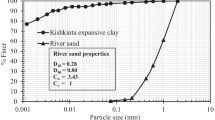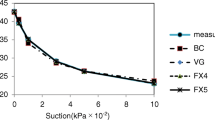Abstract
Despite our best efforts to reduce the waste stream, there will always remain some residues which cannot be further treated and must be disposed in landfills. One critical aspect of landfill construction is the integrity of the landfill liner. Current landfill liner technology includes a composite liner which consists of a FML component and a compacted soil component. The primary characteristic for selecting a soil for use in composite liner construction is that the soil have a saturated hydraulic conductivity of 1 × 10−7 cm s−1 or less. In the present study the effects of desiccation cracks on the hydraulic conductivity of the compacted soil were measured. Two soils of diverse mineralogy and typical of soils used for clay liner construction were selected for use. Each was tested in its native state plus after the addition of 30% sand. Laboratory measurements were made of the volumetric shrinkage of each soil. In addition, the hydraulic conductivity was determined using 10 cm diameter fixed wall permeameters. Additional conductivity measurements were made using 60 cm diameter fixed wall double ring permeameters which had been exposed to 0, 1, and 2 periods of desiccation prior to hydraulic conductivity determinations. The data show that laboratory measurements using 10- cm diameter fixed wall permeameters underestimate the hydraulic conductivity of the same soils when packed in large diameter permeameters. It was also found that exposure to two cycles of desiccation resulted in large increases in hydraulic conductivity. The time required to reach a steady outflow volume decreased as the amount of desiccation increased. The hydraulic conductivities of soils which had been allowed to dry were greater than those which were not allowed to dry prior to measurement. The relationship between volumetric shrinkage and the increase in hydraulic conductivity after desiccation indicates that soils which exhibit less than 11% shrinkage in the laboratory, exhibit increases in K of less than a factor of 2 upon desiccation. Clay soils with greater than 11% shrinkage can potentially be amended with sand to decrease the volumetric shrinkage and their response to desiccation.
Similar content being viewed by others
References
Anderson, D. C., Brown, K. W. and Thomas, J. C.: 1985, Waste Management & Research 3, 339.
Anderson, D. C., Lupo, M. J., Rehage, J. A., Sai, J.O., Shiver, R. L. and Speake, R. C., Brown, K. W. and Daniel, D.: 1991, Factors Controlling Minimum Soil Liner Thickness, USEPA Rep. 600/S2-91/008.
Bowders, J. J., Jr. and McClelland, S.: 1994, ‘The effects of freeze/thaw cycles on the permeability of three compacted soils’, in Daniel, D. E. and Trautwein, S. J. (eds.), Hydraulic Conductivity and Waste Contaminant Transport in Soils, ASTM STP 1142, American Society for Testing and Materials, Philadelphia, PA, pp. 461–481.
Boyton, S. S. and Daniel, D. E.: 1985, J of Geotechnical Eng. 111, 1.
Brasher, B. R., Franzmeier, D. P., Valassis, V. and Davidson, S. E.: 1966, Soil Science 101, 108.
Bronswijk, J. J. B.: 1988, Soil Sci, Soc. Am. J. 54, 1500.
Brown, K. W. and Anderson, D. C.: 1983, Effects of Organic Solvents on the Permeability of Clay Liners, USEPA Rep. EPA-600/2-83-016.
Brown, K. W. and Thomas, J. C.: 1988, J. Hazardous Matls. 18, 179.
Brown, K. W., Thomas, J. C., and Green, J. W.: 1984, Permeability of compacted soils to solvent mixtures and petroleum products, Land Disposal of Hazardous Waste. Proceedings of the 10th Annual Research Symposium at Ft. Mitchell, Kentucky, EPA 600/9-84-007, pp. 124–137.
Daniel, D. E.: 1984, J. Geotechnical Eng. 110, 285.
Daniel, D. E. and Brown, K. W.: 1987, ‘Landfill Liners: How Well do They Work and What is Their Future?,’ in Gronow, J. R., Schofield, A. N. and Jain, R. K. (eds.), Land Disposal of Hazardous Waste: Engineering and Environmental Issues, Ellis Horwood Publishers, Chickester, West Sussex, England, pp. 235–244.
EPA.: 1986, Design, Construction, and Evaluation of Clay Liners for Waste Management Facilities, EPA/530-SW-86-007.
Fickies, R. H., Fakundiny, R. H. and Mosley, E. T.: 1979, Geotechnical Analysis of Soil Samples from Test Trench at Western New York Nuclear Service Center, Report to U.S. Nuclear Regulatory Commission, West Valley, N.Y.
Gee, G. W. and Bauder, J. W.: 1986, ‘Particle-Size Analysis,’ in: Klute, A. (ed.), Methods of Soil Analysis Part 1. Physical andMineralogicalMethods, Agronomy Monograph No. 9 (2nd Edition), American Society of Agronomy, Inc. Madison, WI, pp. 383–412.
George, K. P.: 1968, Highway Research Record. 225, 59.
George, K. P.: 1969, Highway Research Record. 263, 47.
Gray, D. H.: 1989, ‘Geotechnical Engineering of Land Disposal Systems,’ in Baccini, P. (ed.), The Landfill: Reactor and Final Storage, Lecture Notes in Earth Science 20, Springer-Verlag, New York, pp. 145–173.
Hawkins, R. H. and Horton, J. H.: 1967, Bentonite as a Protective Cover for Buried Radioactive Waste, Savannah River Laboratory, du Pont de Nemours and Company, Aiken, South Carolina.
Kays, W. B.: 1977, Construction of Lining for Reservoirs, Tanks, and Pollution Control Facilities, John Wiley and Sons, Inc., New York, N.Y., p. 379.
Kleppe, J. H. and Olson, R. E.: 1985, ‘Desiccation Cracking of Soil Barriers,’ in Johnson, A. I., Frobel, R. K., Calalli, N. J. and Pettersson, C. B. (eds.), Hydraulic Barriers in Soil and Rock, ASTM STP 874, pp. 263–275.
Lambe, T. W.: 1958, J. Soil Mechanics and Foundations Division, Proceedings of the American Society of Civil Engineers SM2. 1654-1-1654-34.
Othman, M. A., Benson, C. H., Chamberlain, E. J. and Zimmie, T. F.: 1994. «Laboratory Testing to Evaluate Changes in Hydraulic Conductivity of Compacted Clays Caused by Freeze-thaw,’ in Daniel, D.E., and Trautwein, S.J. (eds.), Hydraulic Conductivity and Waste Contaminant Transport in Soils, ASTM STP 1142, American Society for Testing and Materials, Philadelphia, PA. pp. 227–254.
Phifer, M. A., Drumm, E. C. and Wilson, G. V.: 1994, ‘Effects of Post Compaction Water Content Variation on Saturated Conductivity,’ in Daniel, D. E. and Trautwein, S. J. (eds.), Hydraulic Conductivity and Waste Contaminant Transport in Soils, ASTM STP 1142, American Society for Testing and Materials, Philadelphia, PA, pp. 318–334.
Prudic, M. B. and Randall, A.: 1979, ‘Ground-Water Hydrology and Subsurface Migration of Radioisotopes at a Low-Level Radioactive Waste Disposal Site, West Valley, N.Y,’ Management of Low-Level Radioactive Waste, Vol. II, Pergamon Press, New York, pp. 853–882.
Ritchie, J. T. and Adams, J. E.: 1974, Soil Sci. Soc. Amer. Proc. 38, 131.
Sherard, D. L. and Decker, R. S.: 1977, ‘Summary-Evaluation of the Symposium on Dispersive Clays,’ in Sherard, J. L. and Decker, R. S. (eds.), Dispersive Clays, Related Piping and Erosion in Geotechnical Projects, ASTM STP 623, American Society for Testing and Materials, pp. 467–479.
Vipulanandan, C. and Leung, M.: 1990, ‘Laboratory Evaluation of Repairing Cracked Kaolinite Clay Under Hazardous Waste Environment’, Proceedings of the 7th National Conference on Hazardous Wastes and Hazardous Materials, St. Louis, MO, pp. 119–122.
Westergaard, H. M.: 1926, Highway Research Board Proc. 6, 201.
Wilson, S. D.: 1950, Engineering News Record, November 2, 1950, pp. 34–36.
Author information
Authors and Affiliations
Additional information
Contribution of the Texas Agricultural Experiment Station, Texas A&M University, College Station, TX 77843. This work was supported in part through award #89-06445 from the United States EPA Hazardous Substance Research Center for Regions 4 & 6 (Award #R815718) in Raleigh, NC
Rights and permissions
About this article
Cite this article
Omidi, G.H., Thomas, J.C. & Brown, K.W. Effect of desiccation cracking on the hydraulic conductivity of a compacted clay liner. Water Air Soil Pollut 89, 91–103 (1996). https://doi.org/10.1007/BF00300424
Received:
Accepted:
Issue Date:
DOI: https://doi.org/10.1007/BF00300424




